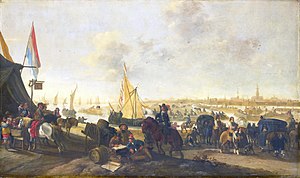
The Battle of Nördlingen took place on 6 September 1634 during the Thirty Years' War. A combined Imperial-Spanish force inflicted a crushing defeat on the Swedish-German army.
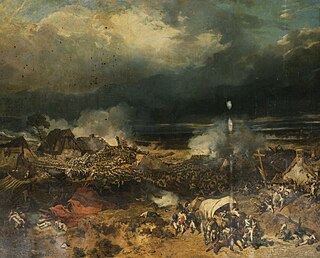
The Battle of Wattignies saw a French army commanded by Jean-Baptiste Jourdan attack a Coalition army directed by Prince Josias of Saxe-Coburg-Saalfeld. After two days of combat Jourdan's troops compelled the Habsburg covering force led by François Sébastien Charles Joseph de Croix, Count of Clerfayt to withdraw. The War of the First Coalition victory allowed the French to raise the siege of Maubeuge. At a time when failed generals were often executed or imprisoned, Jourdan had to endure interference from Lazare Carnot from the Committee of Public Safety. The village, renamed Wattignies-la-Victoire in honor of the important success, is located 9 kilometres (6 mi) southeast of Maubeuge.
The Polish–Swedish War of 1626–1629 was the fourth stage in a series of conflicts between Sweden and Poland fought in the 17th century. It began in 1626 and ended four years later with the Truce of Altmark and later at Stuhmsdorf with the Treaty of Stuhmsdorf.

The Battle of Kallo was a major field battle fought from 20 to 21 June 1638 in and around the forts of Kallo and Verrebroek, located on the left bank of the Scheldt river, near Antwerp, during the second phase of the Eighty Years' War. Following the symbolic recovery of Breda during the 1637 campaign, the Dutch Republic agreed with the French Crown, with whom it had allied in 1635, to besiege a major city in the Spanish Netherlands during the 1638 campaign. The commander of the Dutch States Army, Frederick Henry of Orange, planned an approach over Antwerp from the two sides of the Scheldt. After marching the army, Frederick Henry transferred 50 barges to Count William of Nassau-Siegen and he was left entrusted to land in the Spanish-controlled Waasland region, west of Antwerp, to seize the forts of Kallo and Verrebroek, along with several other key fortifications, to invest Antwerp from the west. In the meantime, Frederick Henry would advance on the opposite bank to complete the blockade of the city while the armies of France invaded the Spanish Netherlands from the south to oblige the Spanish Army of Flanders to divide its forces.

The siege of Maastricht was fought between 9 June and 22 August 1632, when the Dutch commander Frederick Henry, Prince of Orange, eventually captured the city from Habsburg forces.

The Battle of Ekeren, which took place on 30 June 1703, was a battle of the War of the Spanish Succession. A Bourbon army of around 24,000 men, conisting of troops from France, Spain and Cologne, surrounded a smaller Dutch force of 12,000 men, which however managed to break out and retire to safety.
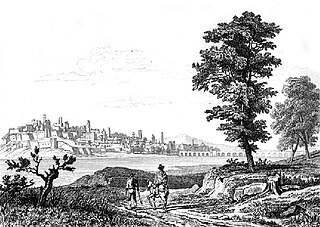
The Battle of the Gebora took place during the Peninsular War between Spanish and French armies on 19 February 1811, northwest of Badajoz, Spain. An outnumbered French force routed and nearly destroyed the Spanish Army of Extremadura.

The Dano-Swedish War of 1658–1660 was a war between Denmark–Norway and Sweden, with the former backed by the Dutch Republic and Poland. It is known in Denmark as the Second Karl Gustav War, in Norway as Bjelkes Feud in Sweden as Karl Gustav's Second Danish War, and in the Netherlands as the Swedish-Dutch War.
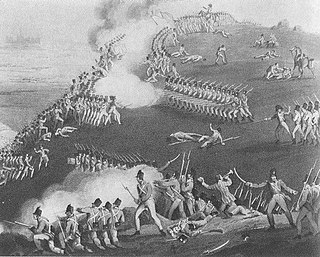
In the Battle of Castalla on 13 April 1813, an Anglo-Spanish-Sicilian force commanded by Lieutenant General Sir John Murray fought Marshal Louis Gabriel Suchet's French Army of Valencia and Aragon. Murray's troops successfully repelled a series of French attacks on their hilltop position, causing Suchet to retreat. The action took place during the Peninsular War, part of the Napoleonic Wars. Castalla is located 35 kilometers north-northwest of Alicante, Spain.
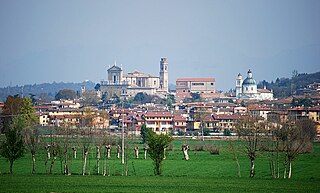
The Battle of Castiglione took place near Castiglione delle Stiviere in Lombardy, Italy on 8 September 1706 during the War of the Spanish Succession. A French army of 12,000 attacked a Hessian corps of 10,000 that was besieging the town and forced them to retreat with heavy losses.
The Battle of Vlotho was fought on 17 October 1638. It was a victory for the Imperial Army under the command of Field Marshal Melchior von Hatzfeldt, and ended the attempt by Charles I Louis, Elector Palatine, to recapture the Electoral Palatinate.

The siege of Leuven was an important siege in the Thirty Years' War in which a Franco-Dutch army under Frederick Henry of Orange and the French Marshals Urbain de Maillé-Brezé and Gaspard III de Coligny, who had invaded the Spanish Netherlands from two sides, laid siege to the city of Leuven, defended by a force of 4,000 comprising local citizen and student militias with Walloons, Germans, Spanish and Irish of the Army of Flanders under Anthonie Schetz, Baron of Grobbendonck. Poor organization and logistics and the spread of sickness among the French, along with the appearance of an Imperial-Spanish relief army of 11,000 under Cardinal-Infante Ferdinand and Ottavio Piccolomini, forced the invading army to lift the siege. This failure allowed the Spanish forces to take the initiative and soon the invaders were forced into a headlong retreat.

André Joseph Boussart or André Joseph Boussard was a French soldier and general. He enlisted in the army of Habsburg Austria as a youth. A Belgian by birth, he joined the Brabant Revolution against Austria and fled to France when the rebellion collapsed. He soon found himself fighting for France during the French Revolutionary Wars. Promoted to general officer during the French Campaign in Egypt and Syria, he returned to France where he held several non-combat posts.

The Battle of Saguntum saw the Imperial French Army of Aragon under Marshal Louis Gabriel Suchet fighting a Spanish army led by Captain General Joaquín Blake. The Spanish attempt to raise the siege of the Sagunto Castle failed when the French, Italians, and Poles drove their troops off the battlefield in rout. The action took place during the Peninsular War, part of the Napoleonic Wars. Sagunto lies a short distance from the east coast of Spain, about 30 kilometres (19 mi) north of Valencia.
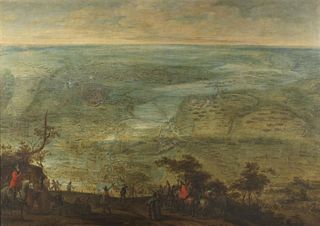
The siege of Saint-Omer was a siege in the Thirty Years' War in which a French army under Gaspard III de Coligny, Maréchal de Châtillon, laid siege to the Flemish city of Saint-Omer, defended by a small garrison in command of Lancelot II Schetz, count of Grobbendonck. Despite several initial successes in the capture of the minor forts around Saint-Omer, on the night of 8/9 June a Spanish relief army under Thomas Francis, Prince of Carignano, surprised Châtillon's troops and established a small fort in the middle of the French lines. An entire army corps under Maréchal de La Force was ordered to move towards Saint-Omer to support Châtillon siege, but on 12 July a further Imperial-Spanish force commanded by Ottavio Piccolomini entered Saint-Omer, resolving the French marshals to withdraw.

The Battle of the Lippe was a cavalry action fought on 2 September 1595 on the banks of the Lippe river, in Germany, between a corps of Spanish cavalry led by Juan de Córdoba and a corps of Dutch cavalry, supported by English troops, led by Philip of Nassau. The Dutch stadtholder Maurice of Nassau, taking advantage of the fact that the bulk of the Spanish army was busied in operations in France, besieged the town of Groenlo in Gelderland, but the elderly governor of the citadel of Antwerp, Cristóbal de Mondragón, organized a relief army and forced Maurice to lift the siege. Mondragón next moved to Wesel, positioning his troops on the southern bank of the Lippe river to cover Rheinberg from a Dutch attack. Maurice aimed then, relying on his superior army, to entice Mondragón into a pitched battle, planning to use an ambush to draw the Spanish army into a trap. However, the plan was discovered by the Spanish commander, who organized a counter-ambush.

The siege of Lochem also known as the Relief of Lochem was a siege that took place in the Dutch city of Lochem during the Eighty Years' War and the Anglo–Spanish War. The city was relieved by a States army composing of English and French Huguenot troops under Count Philip of Hohenlohe-Neuenstein and William Louis of Nassau-Dillenburg and John Norreys on September 24, 1582. This marked the end of the Spanish siege of the city by the Spanish general Francisco Verdugo.
The Battle of Wismar took place on December 5, 1711 close to Wismar, Swedish Empire during the Great Northern War. A 3,000 strong Danish force under the command of Jørgen Rantzau blocked the Swedish city of Wismar. The Swedes under Martin von Schoultz, sent out 2,500 men from their garrison in an attempt to surprise the Danish forces camping a distance away. However, the Danish commander got words of the approaching Swedes and countered them, resulting in 478 Swedes dead, with another 1,500 captured to only 300 Danes killed and wounded.

The Battle of Arnhem saw Friedrich Wilhelm Freiherr von Bülow's Prussian corps fight an Imperial French division under Henri François Marie Charpentier at Arnhem. Attacking under the cover of fog, the Prussians broke into the city at several points and forced the French to retreat to Nijmegen after hard fighting in this War of the Sixth Coalition clash. Arnhem is a city in the Netherlands located on the Rhine River 100 kilometres (62 mi) southeast of Amsterdam.

The siege of Thionville was the siege of the town of Thionville during the Italian War of 1551–59. It was held by the Spanish against a French force under Francis, Duke of Guise and others. It lasted from 17 April to 23 June 1558 and resulted in a French victory.
